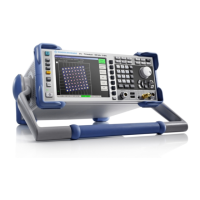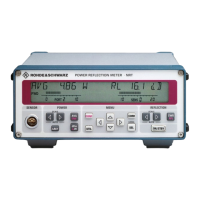Using the Display Line R&S FSH
1309.6275.12 4.32 E-2
Using the Display Line
In addition to the markers, the R&S FSH provides a horizontal line for determining the signal level in the
display.
Press the LINES key.
Press the DISPLAY LINE softkey.
The R&S FSH displays a horizontal line across the
entire diagram. The Y position of the line is indicated at
the top left of the diagram (Line: -55 dBm in the
diagram shown at the right).
The line can be moved in the Y direction with the
cursor keys or the rotary knob, or a level position
can be entered with the numeric keys.
Terminate the entry with the ENTER key.
The softkey label DISPLAY LINE is printed on a green
background and the entry box is cleared.
In contrast to the markers, the position of the displayed line is pixel-oriented. The line resolution in the Y
direction therefore depends on the measurement range set in the Y direction. For a display range of
100 dB, it is 0.3 dB. When the line is set with the rotary knob, the R&S FSH always uses the step width
of the display resolution in the Y direction, e.g. 0.3 dB for a 100 dB level measurement range. The
cursor keys, on the other hand, always move the line by 10 % of the display range in the Y direction.
For fast setting of the display line, we therefore recommend to set the line near the desired position with
the cursor keys and then to use the rotary knob for fine adjustment.
Using Limit Lines
Limit lines are used to set limits for level characteristics versus time or versus frequency on the screen;
they must not be exceeded. For instance, the upper limits of permissible spurious or harmonics of a
DUT are marked by limit lines. In the R&S FSH, the upper and lower limit value can be preset by way of
limit lines. Thus, a spectrum or level characteristic in the time domain (span = 0 Hz) can be checked
either visually on the screen or automatically by verifying limit violations.
A limit line consists of at least two and at most 25 value pairs (points) on the x axis (frequency, time or
length) and the y axis (level). The R&S FSH links the individual points by straight lines. The values on
the x axis may be specified in absolute units (e.g. frequency in MHz) or relative units referenced to the
center of the measured trace (e.g. center frequency). Relative units are of advantage, for instance,
when modulated output signals are measured. If the center frequency is varied, the mask on the screen
remains unchanged. The points on the y axis are always dB values. If the scale on the y axis is linear
(unit V or W), the R&S FSH automatically switches to the respective dB unit after a limit line has been
switched on.
Limit lines are defined with the aid of control software FSH4View. They are loaded into the memory of
the R&S FSH via the USB- or the LAN-interface. Up to 100 limit lines can be stored simultaneously in
the R&S FSH memory. The maximum number of limit lines may be reduced if transducer factors,
channel tables, cable models, or data sets are stored simultaneously (see "Saving and Loading
Instrument Settings and Measurement Results" in this chapter )

